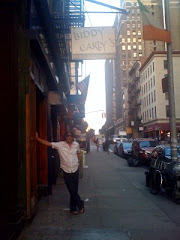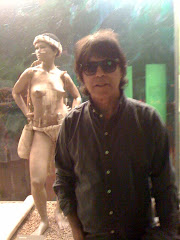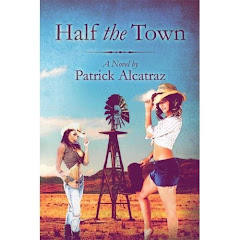 By Patrick Alcatraz
By Patrick Alcatraz Monday, June 29, 2009
I'll Be Home For Xmas...
 By Patrick Alcatraz
By Patrick Alcatraz Friday, June 26, 2009
And Then He Was Gone...
 "...you may leave here for four days in space, but when you return it's the same old place." - Barry McGuire
"...you may leave here for four days in space, but when you return it's the same old place." - Barry McGuireSaturday, June 20, 2009
Wheelhouse Romance, Chapt. 15, Verse 22
 By Patrick Alcatraz
By Patrick AlcatrazTuesday, June 16, 2009
Ragging On Traffic, A New Sport...

Saturday, June 13, 2009
Midnight In Mexico...
 “Standing next to me in this lonely crowd is a man who swears he's not to blame.All day long I hear him shout so loud, crying out that he was framed...” – Bob Dylan
“Standing next to me in this lonely crowd is a man who swears he's not to blame.All day long I hear him shout so loud, crying out that he was framed...” – Bob DylanBy Patrick Alcatraz
Editor
McALLEN, Texas – A Starbucks coffee shop on North 10th Street here is hardly the center of political thought on all to do with today’s Mexico. It is a small business with a steady clientele largely interested in sipping a cup of Joe while reading the morning edition of The McAllen Monitor or while catching up with office work via laptop computer. Noise is minimal, the setting amplified only by the sometimes fighting rock ‘n roll music coming out of the overhead speakers. This is where I meet two gentlemen knowledgeable about the doings south of the border. Mauro and Teto, no last names this close to Mexico, talk as if on Talk Radio or some safe street corner where they can blast the politics and corruption of their native country without fear of sniper fire.
It is not with pride that they do it, however. Their anger is visible and comes with the full weight of two men looking to spread the news, and wishing that others would join them, as well. Mauro is in his 60s, Teto a bit younger. Both come and go across the dividing Rio Grande. Both will tell you they believe Mexico is corrupt from bottom to top, from the small town cop to the president. Neither pulls punches. They see things back home so out of control, so at the mercy of the drug cartels, that to say that they see the light at the end of the proverbial tunnel is to believe that tunnel is not a million miles-long. That large contingent of army personnel sent to the border by Mexican President Felipe Calderon a few months back? Mauro and Teto say it’s all “part of the show.”
“When the PRI (Mexico’s once-ruling political party) lost its first presidential election two rounds ago, the party released the dogs,” says Teto, a burly, balding man in his early-fifties. “The dogs were always there, but the PRI controlled them. Those dogs are now part of the mayhem spreading across Mexico.”
The mayhem he speaks about is largely the drug business. Mexico’s cartels used to be six in number. Today, because of disarray in political power, the number may be as many as a dozen. Deep in the mud of illegal activity, they both say, is the federal government. Corruption is a staple in countries south of the American border. Some of it is sanctioned by the powers-that-be, and some of it is allowed by the citizenry, but the idea that the administration of President Felipe Calderon, a champion of democracy to American politicians that includes President Barack Obama, is complicit has been mainly an internal assessment for the Mexican citizenry.
My entry into Mexican politics came when I traveled around the country while writing for The Houston Post in the late-1980s, when Mexico was another Mexico, when the PRI ruled without competition, when the country was known as a “trampoline” for Colombian drugs and not as a country where the richest drug lord grabbed a place atop Forbes Magazine’s Richest Men In The World survey. Mexico is No. 1 these days as a mover & shaker in the hemisphere drug trade. The infiltration has taken over towns, cities, regions and states. Drug moguls now communicate with political candidates, or so said a current candidate for mayor of San Pedro Garza - a suburb of Monterrey acknowledged as the richest city in Mexico. It is a tremendous flash-forward into the narco-business for a poor country that often boasted its income came from oil and from tourism. Today, the trafficking of illegal drugs reigns supreme. Mexicans fight to get into the game and many are glad to die while wearing wildly-expensive alligator boots and belts, their however-shortened lives at the very least coming with some “respect” from local authorities not used to paying such compliments to the uneducated and the uncouth.
So, when I ask my friends Mauro and Teto for more info, they hit me with this stunner at me: the wife of former Mexican President Vicente Fox is related to the country’s billionaire drug lord, a physically-eccentric dude known quite widely by his nickname of “El Chapo,” the same cat listed as a rich dude by Forbes Magazine, right up there with Bill Gates and Warren Buffet and a few others not exactly tied to the illegal drug industry. “Everybody knows that,” Teto repeats when I ask him to confirm what I just heard. Mauro throws out: “The Bishop of the region where he lives said it! He told the congregation he had no idea why Mexico was saying they didn’t know where Joaquin "El Chapo" Guzman was when everybody in town knows exactly where El Chapo lives!”
Wild, I think, throwing frames onto my brain that come with the sort of assessments about Mexico I’ve heard coming from Washington, D.C. Didn’t President Obama visit with Mexican President Calderon in Mexico City – what? – last month? Didn’t American Secretary of State Hillary Clinton visit with Mexican officials in Monterrey, Mexico a few months back? In there somewhere was word that the government would be funneling still more drug-war millions to Mexico for continuation of that endless scrap. And I know I’ve heard Calderon characterized as being against illegal drugs and against government corruption.
That is when Mauro threw a book at me by a Mexican journalist by the name of Anabel Hernandez. “She has the balls male reporters in Mexico don’t have,” he said in a voice that rose with every word. “Read the book. You’ll see that what we’re saying is true. But there is more, much more!”
The book is “Los Complices del Presidente (The President’s Accomplices).” It is an eye-opening book that paints a different portrait of Calderon and his PAN Party administration. In its 412 pages, readers will find a mountain of examples of corruption and facts supporting allegations. The story of Calderon cabinet member Juan Camilo Mourino, then-Secretary of State, is especially touching, if that’s even the word. Mourino was killed last November 4th in a plane crash many said was mysterious. The government said the aircraft merely flew too close behind the wake of a larger airliner and its inexperienced pilot lost control. Mourino had been accused of okaying, as Secretary of Energy, more than 160 contracts with the country’s national petroleum company, PEMEX, for his family’s gasoline station enterprise, Ivancar, S.A. A government probe cleared Mourino, but the allegation gained footing with the citizenry to the extent that President Calderon is said to have felt the pressure of an independent review. In her book, Anabel Hernandez offers what look like copies of some of the contracts in question. They bear Mourino’s signature and government stamp. When all blame was removed from Mourino’s back by the government, Journalist Hernandez, through her book publicist, declared that it was “an example of the official impunity.” She noted that the contracts in question, said to be only 8 by the government probe team, was actually the more than 160 she later noted in her book.
It was, she went on, proof that the “government continues to sanction corruption and, even when there exist public denunciations, the same officials continue exonerating…”
An experienced reporter, Hernandez also is the author of earlier books that looked into the country’s presidency, the two being “The Presidential Family” and “End of the Party in Los Pinos” – about the presidency of Vicente Fox. Los Pinos is a section of Mexico City home to what is in effect the Mexican White House. Both took a hard line on questionable actions by the Fox Administration.
It is not a new thing. Corruption in Mexico is both historic and cultural. The Latino way of doing things lends itself to backslappings and glad-handing. Here, along the border, the “mordida,” or pay-off at the Mexican customs stations when one heads across is legendary. Jobs of any significance come only through long and discernible party loyalty. And, lately, the fact that Mexico’s economy now wrests on illegal drug trafficking has led to the enlistment of young people into the street-fighting fray. It is not uncommon for a cartel hit man to be a 17-year-old punk making more money in that capacity than anything earned by his family in the history of his DNA. Life suddenly is very good for anyone wishing to ally in the war, for the drug dealers especially. “The government stuff is just show,” Teto insists. “They don’t want to get rid of the cartels. What for? Some of these government officials are getting fifteen or twenty-thousand dollars a month to look the other way.”
And, he notes with a facial expression that says no shit, man, “Who do you think is building the schools and hospitals in Mexico? It’s the narcos! They seek free passage for their drugs and they’ll be asked for payment that sometimes may be construction of a school, or small hospital. They do it! They have the cash!”
The Texas-Mexico border this far south, from Laredo upriver to Brownsville in the other direction near the Gulf of Mexico, used to be a passive chunk of lands for both countries. The border crossings offered little if any delay and soldiers were as rare as a businessman in a suit. Those days are gone for the Rio Grande Valley where this sits. Today, it is an army of U.S. Border Patrol agents backing an army of U.S. Customs Service agents backing an army of immigration agents backing an army of local cops. That’s the obstacle course to beat when headed for Mexico. When coming back, it is almost like a funeral-in-reverse. The Mexicans have their own game. They ask the questions about where you’ve been and what you’re ferrying in your vehicle, but, on the Mexican side, it is a scene out of some action-packed war video game. Dour-faced soldiers in thick green uniforms walk the streets, right past sand-bagged, machine-gun bunkers with a soldier’s finger forever on the trigger. They don’t talk, they don’t smile. They stare ahead for long seconds before their heads then perform a slow swivel that allow them to see the rooftops and the sidewalks and the passing vehicles. They are there 24 hours a day, ready for gunfire that more often than not spills out into the seemingly laid-back landscape. It is not war-ravaged Baghdad or Fallujah; it is Reynosa, Mexico – a large border town once the playground of adventurous or bored Rio Grande Valley high school boys looking for a cold beer or a cheap woman on a weekday afternoon when they should’ve been in class.
“Today, even I don't take my wife across the river,” Mauro had told me, emphasizing the “I,” as if it was being uttered by a some tough guy who perhaps earlier in life wouldn’t have tolerated anyone telling him where he could and couldn’t go. It’s now a good idea to follow advice about where to go and where not to go in Mexico.
My conversations with Mauro and Teto took me back to my days as a reporter for The Post in Mexico City, when I would go for my morning coffee at the Havana Cafe near the national government complex. I recall it was abuzz with political chatter that often included assessments from the heady waiters. I remember a lot of the talk back then was about the possibility that the ruling PRI Party might lose a governor's race in the northern part of the country, a region with a history of political insurgencies. A governor's race. That sounds so silly today. The PRI has lost governor races in the interim, and many believe it is the loss of that full-metal hold that has left the country at the mercy of the cash-fat drug lords.
That's what my Starbucks friends meant when they said the dogs had been let loose in Mexico...
- 30 -
[Editor's Note: It goes without saying that we do not offer this as a definitive, end-all report on Mexico. It is but yet another slice of the tale. We encourage discourse, but will end the "anonymous comments" feature simply because, to us, something stinks about "anonymous" writing...]
Friday, June 12, 2009
A Night For Shiraz....
 "Well, I started out on Burgundy and soon hit the harder stuff..." - Bob Dylan
"Well, I started out on Burgundy and soon hit the harder stuff..." - Bob Dylan Contributor
McAllen, Texas – It was a controlled mob that shuffled into Feldman’s last night, guys in suits and dudes in t-shirts and women in corporate wear and chicks in tight jeans and tighter blouses. Vintner’s Night brought out the, well, average, wine-hopping, eager-to-partake locals out for a taste of whatever…
I bopped in with my gal pal who shall, for now, remain anonymous, but whose initials are CM-O. We were late, as those already inside the well-known business barely a block north of Business 83 on the east side of No. 10th busied themselves sipping a variety of wines and gouging at the free cold cuts. A woman in a gray, striped pant suit, presumably just in from a day at the local insurance outfit or law firm, fingered the sliced pepperoni sausage off her plate, while nearby a balding guy in Hawaiian wear sat at a table facing the front door, clearly ogling the women as they stepped in from the 150-degree heat outside. It was, as they say in Hell, just another scorcher in South Texas – a day in June when, it was agreed, a nice, soft red or cooling white would soothe the palate. Bottles fronted a handful of show-off tables, where the vintner reps hawked their best. Somewhere else on the planet, soldiers carried out dangerous recon missions in Iraq and Afghanistan, and somewhere else in the country, Americans mourned the death of a heroic security guard murdered at the Holocaust Museum in the nation’s capital by a racist white supremacist. It was time to get back to basics – to enjoying the best of civilization, especially with a lovely bottle of Shiraz, for me, and perhaps a Cabernet for the ladies.
The Texas-Mexico border around here is these days a veritable socio-minefield. That late-model SUV moving alongside you on any given street or highway could be carrying well-armed thugs ferrying serious drugs somewhere north. The waitress at the café may be a stool pigeon for the feds, out to finger this or that local Bigwig employing undocumented maids and gardeners. It is a Time for Freakin’ Reflection in McAllen, the City of Palms to locals and the Square Dance Capital of America to The New Yorker magazine. Can you stand it? Is this America, or what?
Anyway, we traipsed into the cold tasting room inside the cool wine section of Feldman’s shortly after 7:30 p.m., minutes after the Orlando Magic and Kobe Bryant’s Los Angeles Lakers tipped off in Game Four of the NBA Finals. I reeled at the idea of missing the game in favor of a Minor League wine-tasting outing in a troubled outpost of this Great land. But as the say down here, “When in Rio Grande City, do as the Rio Grande Citians do…” I went in search of The Lost Grape.
Did I find it? Naaaaah. Did I have a good time? Sort of. I met two pleasant teachers from the PSJA school district who kinda conversed lightly with the Ol’ Cowboy, one a science teacher who had no idea how far it is from Earth to the moon. “That’s eighth grade,” she said, noting that she taught a lower-level class. I feigned humor, noting that it was farther, for sure, than it was from McAllen to New York, a point that drew laughter from her and her girlfriend, a woman who had told me she was the school’s principal. It’s not the setting for interrogating our local educators, I finally told myself as the wine kept flowing while the dog-ass Orlando Magic sank not far from Disneyworld…
- 30 -
Thursday, June 11, 2009
Breakfast At Mimi's...
 "Please don't seat us in the whining section..." - A customer at Mimi's, Today
"Please don't seat us in the whining section..." - A customer at Mimi's, Today Tuesday, June 9, 2009
Coming Home...
 "You don't know what's going on, you've been gone for far too long...you can't come back and think you are still mine. You're out of touch, my baby, my poor discarded baby. I said baby, baby, baby, you're out of time..." - Rolling Stones, Out Of Time
"You don't know what's going on, you've been gone for far too long...you can't come back and think you are still mine. You're out of touch, my baby, my poor discarded baby. I said baby, baby, baby, you're out of time..." - Rolling Stones, Out Of TimeWelcome...













.jpg)




